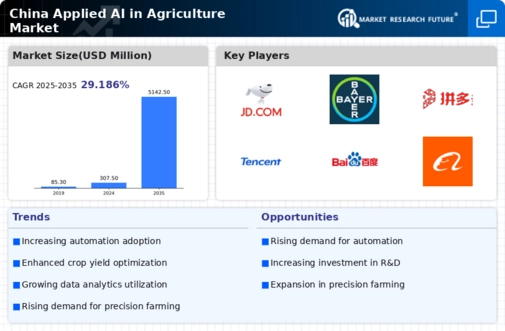Rising Labor Costs
Increasing labor costs in China are compelling farmers to seek automation solutions, thereby driving the applied ai-in-agriculture market. As wages for agricultural workers rise, the financial viability of traditional farming practices is challenged. Consequently, farmers are turning to AI-driven technologies to automate tasks such as planting, harvesting, and monitoring crops. Reports indicate that labor costs in agriculture have risen by approximately 15% over the past five years. This trend suggests that the demand for AI solutions, which can reduce reliance on manual labor, will continue to grow, further propelling the applied ai-in-agriculture market.
Technological Advancements in AI
The rapid evolution of artificial intelligence technologies is a primary driver for the applied ai-in-agriculture market. In China, advancements in machine learning, computer vision, and robotics are enhancing agricultural productivity. For instance, AI algorithms are now capable of analyzing vast datasets to optimize crop yields and resource allocation. The Chinese government has invested heavily in AI research, with funding exceeding $10 billion in recent years. This investment is likely to foster innovation and adoption of AI solutions in agriculture, potentially increasing efficiency by up to 30%. As farmers seek to leverage these technologies, the applied ai-in-agriculture market is expected to expand significantly.
Government Initiatives and Support
Government policies and initiatives play a crucial role in shaping the applied ai-in-agriculture market. In China, the government has launched several programs aimed at promoting smart agriculture through AI technologies. The 'Digital Agriculture Development Plan' aims to integrate AI into farming practices, with a target of increasing agricultural output by 20% by 2027. Additionally, subsidies and grants for AI-based agricultural tools are encouraging farmers to adopt these innovations. The commitment of the Chinese government to enhance food security and sustainability through technology is likely to drive growth in the applied ai-in-agriculture market.
Integration of IoT and AI Technologies
The convergence of Internet of Things (IoT) and AI technologies is a significant driver for the applied ai-in-agriculture market. In China, the deployment of IoT devices in agriculture, such as sensors and drones, is enabling real-time data collection and analysis. When combined with AI, this data can be utilized to make informed decisions regarding crop management and resource allocation. The market for IoT in agriculture is projected to grow at a CAGR of 25% over the next five years. This integration is likely to enhance operational efficiency and productivity, thereby propelling the applied ai-in-agriculture market forward.
Growing Demand for Sustainable Practices
The increasing emphasis on sustainability is influencing the applied ai-in-agriculture market in China. Consumers are becoming more aware of the environmental impact of agricultural practices, leading to a demand for sustainable farming methods. AI technologies can optimize resource use, reduce waste, and minimize chemical inputs, aligning with these sustainability goals. The Chinese government has set ambitious targets for reducing carbon emissions in agriculture, aiming for a 30% reduction by 2030. This regulatory environment is likely to encourage the adoption of AI solutions that promote sustainable practices, thereby driving growth in the applied ai-in-agriculture market.

















Leave a Comment